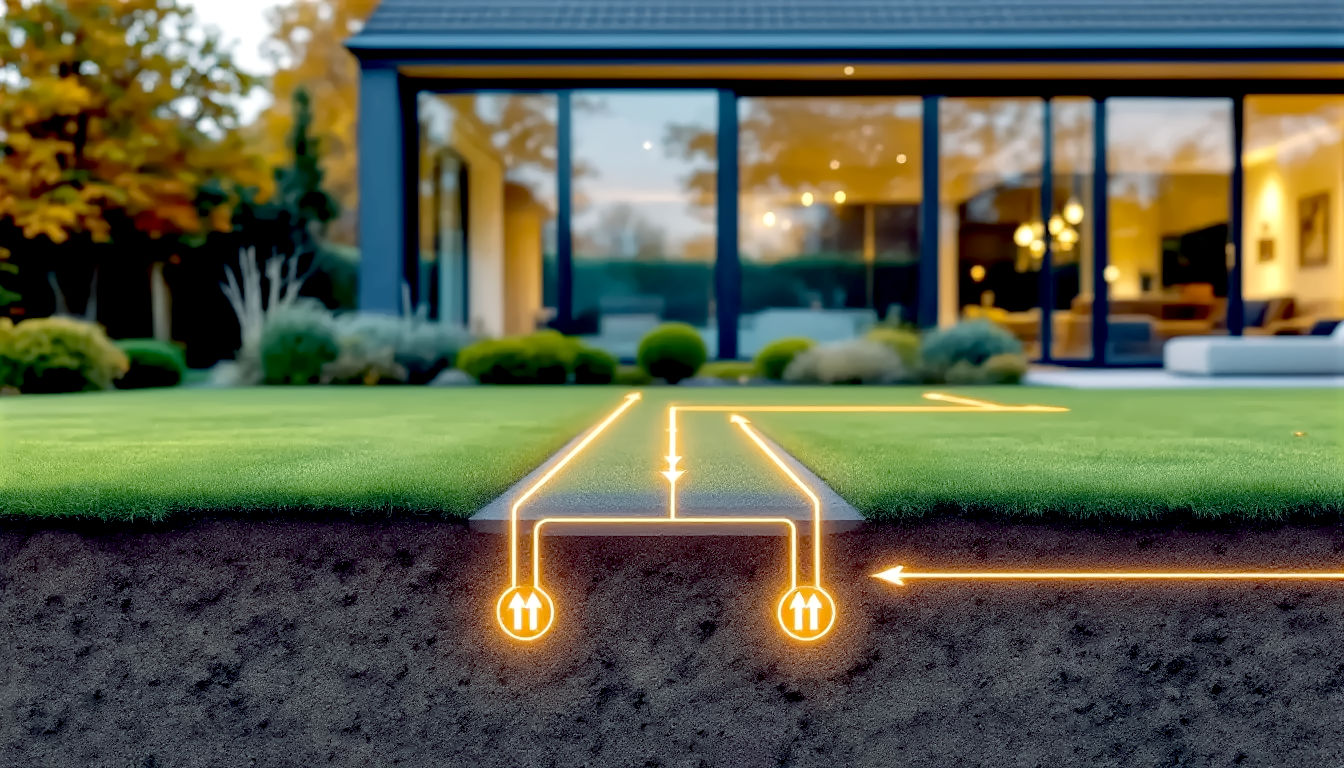Tapping the Earth’s Warmth: How a Ground Source Heat Pump Works
Discover how ground source heat pumps tap into free energy from your garden to heat your home. This complete guide covers costs, grants, and how it all works.

This post may contain affiliate links. If you make a purchase through these links, we may earn a commission at no additional cost to you.
Imagine having a heating system that works a bit like a fridge in reverse, pulling natural, free warmth from your garden to keep your home toasty all winter. It sounds like something from the future, doesn’t it? But it’s not. It’s a ground source heat pump, and it’s one of the cleverest ways to heat a home in Britain today.
As we all think more about our energy bills and our impact on the planet, these systems are becoming a hot topic. They don’t burn any fuel, they just move heat that’s already there, sitting right underneath your lawn. But how exactly do they pull off this magic trick? Is it complicated? Expensive? And could it really work for a typical British home, whether it’s a new build in Milton Keynes or a stone cottage in the Cotswolds?
This guide will answer all of those questions and more. We’re going to dig deep—quite literally—into the world of ground source heat pumps. We’ll explore how they work, where the idea came from, what it takes to install one, and whether it’s the right choice for you and your home. Forget the jargon and the confusing diagrams; we’ll break it all down, step-by-step.
What on Earth Is a Ground Source Heat Pump?
At its heart, a ground source heat pump (GSHP) is a highly efficient central heating system. But unlike a gas boiler, which creates heat by burning fossil fuels, a heat pump doesn’t create heat. It simply moves existing heat from one place to another.
Think about your kitchen fridge. It feels cold inside because it has a system that pulls heat out of the air inside the fridge and releases it from the metal coils on the back. A ground source heat pump does the exact opposite for your home. It pulls heat from the ground outside and moves it inside to warm up your radiators, underfloor heating, and hot water.
Even in the depths of a British winter, when the air is frosty and the sky is grey, the ground just a couple of metres beneath our feet stays at a surprisingly stable temperature. It’s usually around 8-12°C all year round. This is because the ground absorbs and stores a huge amount of energy from the sun.
A GSHP system uses this constant, low-level warmth as its energy source. By using a bit of electricity to power the pump, it can concentrate this gentle ground heat into high-grade heat, warm enough for your central heating. The amazing part is that for every one unit of electricity the pump uses, it can generate three to four units of heat for your home. That’s an efficiency of 300-400%, a figure that makes traditional boilers look incredibly wasteful.
A Quick History: From Lord Kelvin’s Idea to Modern Homes
The idea isn’t new. The basic principle was first described way back in 1852 by the brilliant Belfast-born scientist, Lord Kelvin. He figured out that you could use a refrigeration process to either heat or cool a space. But it took a while for technology to catch up with his theory.
The first person to actually build a working heat pump was an Austrian inventor named Peter von Rittinger in 1856. He used it to dry salt in a salt marsh. However, it wasn’t until the 1940s in America that the first ground source heat pump was used to heat a building. An inventor in Ohio, Robert C. Webber, was tinkering with his deep freezer and accidentally burned his hand on the hot outlet pipe. A lightbulb went off: if that pipe was hot enough to burn him, it was hot enough to heat water. He ran the hot pipe through his water boiler and, before long, he had a system that heated his entire home by drawing heat from the ground.
In the UK, the technology was slower to take off, mostly because we had cheap and plentiful gas from the North Sea. But as concerns about climate change have grown and energy prices have soared, Britain is now catching on fast. The government is even offering grants, like the Boiler Upgrade Scheme, to encourage homeowners to switch from fossil fuels to cleaner alternatives like heat pumps.
The Magic Inside the Machine: How It Actually Works
So, how does a pipe full of cold liquid buried in your garden make your radiators hot? The process involves a clever bit of physics, but it can be broken down into four simple stages. The whole system is made of two main parts: the ground loop (the pipes buried outside) and the heat pump unit itself (a box inside your home, usually in a utility room or garage, that looks a bit like a boiler).
Let’s follow the journey of the heat from your garden to your living room.
Stage 1: Absorbing Heat from the Ground
The process starts in the ground loop. This is a long network of plastic pipe buried in your garden. A mixture of water and antifreeze is pumped through this pipe. This liquid is cold, colder than the ground around it.
As this cold liquid travels through the buried pipes, it acts like a sponge for heat. Because the ground is warmer (that constant 8-12°C), heat naturally flows from the ground into the fluid, warming it up by a few degrees. The liquid goes into the ground cold and comes back out slightly warmer. It hasn’t created any heat, it has simply collected it.
Stage 2: The Compressor and the Vapour Compression Cycle
The slightly warmed liquid from the ground loop now flows into the heat pump unit inside your house. This is where the real magic happens, using something called the vapour compression cycle. It’s the same process your fridge uses, and it relies on a special substance called a refrigerant.
A refrigerant is a fluid with a very low boiling point. The one used in heat pumps will boil and turn into a gas even at temperatures well below 0°C.
- The Evaporator: The liquid from the ground loop passes through a heat exchanger called the evaporator. It flows past the cold liquid refrigerant, and the heat it collected from the ground is transferred to the refrigerant. This is just enough heat to make the refrigerant boil and turn into a low-temperature, low-pressure gas.
- The Compressor: This gas is then sucked into the compressor. The compressor, which is powered by electricity, does exactly what its name suggests: it squeezes the gas into a much smaller space. When you compress any gas, its molecules get squashed together, they move faster, and this dramatically increases its temperature. This is the key step. The low-temperature gas goes in, and a very hot, high-pressure gas comes out. We’re talking temperatures of around 60-80°C.
This is the only part of the process that uses a significant amount of electricity. But by using electricity to power a compressor, we are not creating heat directly; we’re concentrating the free heat we gathered from the ground.
Stage 3: Releasing Heat into Your Home
The hot, high-pressure refrigerant gas now flows into a second heat exchanger, called the condenser. Here, it passes by the cold water from your central heating system (the water that flows to your radiators or underfloor heating).
Because the refrigerant gas is much hotter than the heating water, its heat is transferred across, warming up the water. As the refrigerant loses its heat, it cools down and condenses back into a liquid. This hot water is then pumped around your home to your radiators or underfloor heating pipes, making your house lovely and warm. It can also be used to heat the water in your hot water cylinder for showers and taps.
Stage 4: Starting the Cycle Again
The refrigerant, now a warm, high-pressure liquid, has one final step to go through. It passes through an expansion valve. This valve releases the pressure, causing the liquid refrigerant to become very cold again, even colder than it was at the start.
And now it’s ready to go back to the evaporator to pick up more heat from the ground loop, and the whole cycle starts over again. This process runs continuously, constantly moving heat from the ground to your home whenever your thermostat calls for it.
In a nutshell: A cold fluid in a garden pipe picks up warmth from the earth. Inside the heat pump unit, this warmth is used to boil a refrigerant. A compressor squeezes the resulting gas, making it very hot. This heat is then used to warm up your central heating water. Simple!
Digging Deeper: Types of Ground Loop Systems
Not all gardens are the same, so there are a few different ways to lay the ground loop pipes to collect the earth’s heat. The best option for you will depend on how much space you have, your budget, and the local geology.
Horizontal Trenches: For Those with a Bit of Lawn
This is the most common method for homes in the UK. It involves digging several long, shallow trenches in your garden, typically about 1.2 to 2 metres deep. The plastic ground loop pipes are then laid in these trenches, usually in overlapping coils called ‘slinkies’ to fit more pipe into a smaller area. The trenches are then backfilled.
- Space needed: You need a fair bit of garden space. As a rule of thumb, you’ll need an area of about two to three times the total floor area of your house. So, for a 150 square metre house, you might need a 300-450 square metre patch of ground.
- Pros: It’s generally the cheapest and quickest installation option because the digging is relatively straightforward.
- Cons: It causes a lot of disruption to your garden during installation. You won’t be able to build on top of the trenches (so no extensions or large sheds) and you shouldn’t plant deep-rooted trees there either.
Vertical Boreholes: The Solution for Smaller Spaces
If you don’t have enough garden space for trenches, the alternative is to drill downwards. A borehole system involves a specialist drilling rig boring one or more holes deep into the ground, anywhere from 50 to 150 metres deep. A pair of pipes with a U-bend at the bottom is then inserted into each borehole.
- Space needed: Very little. The drilling rig needs access, but the finished system has a very small footprint, often just a single manhole cover. This makes it perfect for homes with small gardens or even no garden at all (the borehole could be drilled in a driveway).
- Pros: It’s very discreet, has minimal impact on your garden once installed, and can access more stable temperatures deeper underground, which can sometimes make it slightly more efficient.
- Cons: Drilling boreholes is a specialised job and is significantly more expensive than digging trenches. The cost depends on the depth required and the type of rock being drilled through.
Water Source Heat Pumps: Using a Pond or River
If your property is lucky enough to have a large pond, a lake, or a stream nearby, you could opt for a water source heat pump. This is often the most efficient option of all.
Instead of being buried, the ground loop pipes are submerged in the body of water. Water is even better at transferring heat than soil, and the temperature at the bottom of a deep body of water is very stable. The rest of the system works in exactly the same way.
- Space needed: You need a suitable body of water, usually with a surface area of at least 600-800 square metres and a good depth.
- Pros: Can be extremely efficient and often has lower installation costs than a borehole system if the water source is suitable.
- Cons: Only an option for a small number of properties. You will also likely need permits from the relevant UK environmental agency (like the Environment Agency in England or SEPA in Scotland).
Is a Ground Source Heat Pump Right for Your Home?
While the technology is brilliant, it’s not a perfect fit for every single home in Britain. To get the best out of a GSHP, a few things need to be right.
Insulation is King
This is the most important factor. Heat pumps work best when they can deliver heat slowly and steadily at a lower temperature than a traditional boiler. A gas boiler might heat your radiators to 65-75°C, but a heat pump system is designed to run most efficiently when heating them to around 35-45°C.
This lower temperature is lovely and comfortable, but it means your house needs to be good at holding onto its heat. If you live in a draughty, uninsulated house, that gentle heat will escape as fast as the pump can produce it.
So, before you even think about a heat pump, you should look at your home’s insulation. Loft insulation, cavity wall insulation, and double glazing are essential. Think of it this way: there’s no point installing a super-efficient heating system if you’re just going to heat the street outside. An Energy Performance Certificate (EPC) for your home will give you good recommendations on what you can improve.
Underfloor Heating or Big Radiators?
Because the water in the system is at a lower temperature, you need a larger surface area to release that heat into your rooms effectively.
- Underfloor Heating (UFH): This is the perfect partner for a ground source heat pump. The entire floor acts as a giant, low-temperature radiator, which is ideal for the steady heat produced by a GSHP. If you’re building a new home or doing a major renovation, installing UFH is a fantastic choice.
- Larger Radiators: If you have standard radiators, you will almost certainly need to replace them with larger ones. You might need radiators that are two or even three times bigger than the ones you’d use with a gas boiler. This ensures they have enough surface area to heat the room effectively with the lower water temperature. Companies that install heat pumps will do all the calculations to figure out exactly what size you need for each room.
The Financial Side: Costs, Savings, and Grants
Let’s not beat around the bush: installing a ground source heat pump is a big investment.
- Installation Cost: The total cost for a typical UK home can range from £15,000 to £35,000, or even more. The final price depends on the size of the heat pump, whether you choose horizontal trenches or more expensive boreholes, and how much work is needed to upgrade your radiators or hot water cylinder.
- Government Grants: The good news is that the UK government is keen to help. The Boiler Upgrade Scheme (BUS) currently offers a grant of £7,500 to households in England and Wales to help with the upfront cost of switching to a low-carbon heating system like a ground source heat pump. There are similar schemes in Scotland. To be eligible, you’ll need to use an installer and a heat pump that are certified by the Microgeneration Certification Scheme (MCS), which ensures quality.
- Running Costs: This is where you see the return on your investment. Because a GSHP is so efficient, your heating bills can be significantly lower than with gas, oil, or especially electric heating. The exact savings depend on what fuel you’re replacing and how well-insulated your home is, but many people see their bills cut by a third or even a half. You’ll still have to pay for the electricity to run the pump, but you’ll no longer be buying any gas or oil.
- Payback Time: With the grant and the annual savings, the payback period for a GSHP can be anywhere from 7 to 15 years. It’s a long-term investment, but one that adds value to your property and protects you from rising fossil fuel prices.
Living with a Heat Pump: What’s It Really Like?
Switching to a heat pump does involve a slight change in mindset compared to a traditional boiler.
- ‘Low and Slow’ Heating: You don’t tend to use it for quick blasts of heat. Instead, you leave it running at a low, steady level for longer periods. The control system and thermostat are set up to maintain a constant, comfortable temperature throughout the house. Many people find this ‘background’ warmth more pleasant than the hot-then-cold cycle of a boiler.
- Maintenance: Ground source heat pumps are incredibly reliable. The ground loop has no moving parts and should last for over 100 years. The heat pump unit itself has a lifespan of around 20-25 years, similar to a good quality boiler. They need an annual service check, just like a boiler, to make sure the refrigerant levels are correct and everything is running efficiently.
- Noise: The heat pump unit inside your home makes a noise similar to a modern fridge or freezer. It’s a low hum. It’s not silent, but it’s generally installed in a utility room or plant room where the noise won’t be a bother. There is no noisy unit outside your house, unlike with an air source heat pump.
The Big Picture: Environmental Benefits
The main reason the government is so keen on heat pumps is their environmental credentials. By switching from a gas boiler to a ground source heat pump, a typical UK household can reduce its carbon footprint from heating by over 70%.
They don’t produce any local air pollution, unlike burning oil or wood, so they help improve air quality. And as the UK’s electricity grid gets greener, with more power coming from wind and solar, the carbon footprint of running a heat pump gets smaller and smaller every year. They are a key part of the UK’s plan to reach its net-zero carbon emissions target by 2050.
The Future of Heating in Britain
Ground source heat pumps are more than just a clever piece of technology; they represent a fundamental shift in how we think about keeping our homes warm. Instead of burning finite resources, we’re starting to harvest the renewable energy that’s all around us, and right under our feet.
As technology improves, heat pumps will become even more efficient and smarter, able to interact with the grid to run at the cheapest and greenest times of the day. We’re also seeing the growth of shared ground loops for new housing estates, where a whole street can draw heat from a shared network of boreholes, reducing the cost for everyone.
Making the switch is a big decision, and it requires careful thought and a significant upfront investment. But for well-insulated homes with a bit of space, a ground source heat pump offers a future of low running costs, low carbon emissions, and a quiet, comfortable, and reliable way to stay warm through the coldest British winters. It’s a technology that harnesses the gentle, constant warmth of the earth itself, giving us a truly sustainable way to heat our homes for generations to come.
Further Reading
For those looking to delve deeper, these resources provide reliable and detailed information for UK homeowners:
- Energy Saving Trust: An independent organisation offering impartial advice on energy efficiency and renewables. Their pages on ground source heat pumps are an excellent starting point.
- Microgeneration Certification Scheme (MCS): The official standards body for low-carbon home energy tech in the UK. Their website helps you find certified installers and products, which is essential for accessing government grants.
- Gov.uk – Boiler Upgrade Scheme: The official government page with the latest details on grants available for installing heat pumps in England and Wales.
- Ground Source Heat Pump Association (GSHPA): The UK’s trade association for the industry, offering technical information and a list of members.






